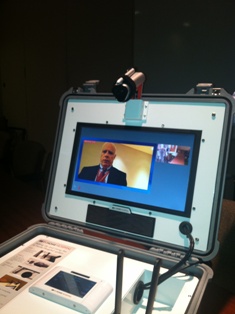|
Common Technology Could Change Health Care Delivery  The biggest change to hit health care in the next few years may not be the Affordable Care Act. It may be technology. Smart phones, face time and medical kiosks might all become alternatives to the waiting room, the hospital, even the nursing home. [An example of the In Home Hospital's camera-equipped computer that allows Dr. Tim Bullard to face-time with patients] “He was like the Marcus Welby, you know, that used to be on T-V, that used to come to your house,” says 56-year old John Warrington. The character from the popular 1970’s medical drama Marcus Welby, M.D. was known for making house calls. Warrington’s recent hospital stay reminded him of Marcus Welby, except he wasn’t in the hospital. He was at home face-timing with his doctor. “I was pretty terrified to stay in the hospital to be honest with you,” he says. He participated in a new program being piloted by Orlando Regional Medical Center called In Home Hospital. Patients with certain diagnosis who need monitoring and intravenous medication are sent home with a computer, a blood pressure cuff, and an I-V. Nurses visit the patient at home to explain all of the equipment. They teach the patient how to measure needed vitals like blood pressure and pulse. Instead of a nurse recording all that, the computer records it. “And then it fed the information back to the hospital and then a short time later the doctor would call me and the picture was clear, like he was sitting right across the room from me,” says Warrington. He says the experience was great. Patient satisfaction like that is one of the big reasons ORMC is doing the pilot. ORMC Business Development and Innovation Medical Chief Dr Tim Bullard says the In Home Hospital should also result in fewer patient infections and fewer falls. “Also in the future, with more bundled payment, this looks like it might be a more cost effective model for delivering care,” says Bullard. Technology could become a cost-savings tool in all areas of medicine. Health Council of East Central Florida Executive Director Ken Peach says the same kinds of technology being used for In Home Hospital could help keep people out of nursing homes. Programs being piloted right now use combinations of motion detectors, cameras and wireless communication wristbands to keep patients at home up to age 105- at a cost of $425 a month. “Now that seems like a lot, but it’s less than 6-thousand dollars compared to a nursing home at 60-thousand dollars a year,” says Peach. Smart phones and tablets are already playing a big role. Smart phones can replace EKGs, ultrasounds- even stethoscopes. Think you have a suspicious mole? What if you could simply snap a picture of it and send it to your doctor. Bullard says this kind of technology is already ubiquitous among doctors. “And you know the beauty of that is you can be virtually anywhere and connect up with the patient,” he says. Mobile devices are also being used to avoid needing a doctor in the first place by helping people stay healthier. There are apps that will log your runs and track your calorie intake. Or maybe you need to develop a whole new set of habits. Florida Hospital’s Healthy 100 Habits app is designed to do just that. Psychologist Indira Abraham-Pratt is part of the hospital’s Center for Child and Family Wellness. She says the app is going over well with kids in particular. “Kids love this type of technology, they get that visual feedback from the app, you know you can set up stars, you can set up happy faces when they do meet their goals, so they like getting that reinforcement,” says Abraham-Pratt. Technology is even expected to change retail health. Instead of visiting a nurse practitioner at a drug store clinic, maybe you’ll visit a stand alone kiosk that has all of the tools for doing a tele-visit with a doctor. Peach says those types of kiosks are even showing up in the work place. “Now you would go to a kiosk at your employer in the morning or when you’re not feeling well, those kiosks can be arranged so they give you an option to basically seek more care, get more information,” he says. Telemedicine, as it’s sometimes called, has great potential for bringing down costs while improving patient care. But even more than that- if tablets and smart phones can be used as diagnostic tools- then health care can be brought to anyone- no matter where they live. |
|
|